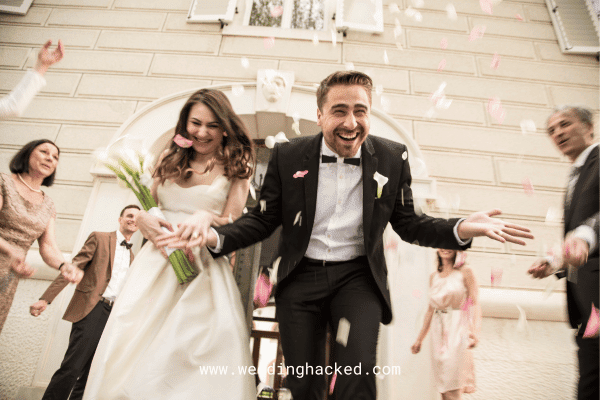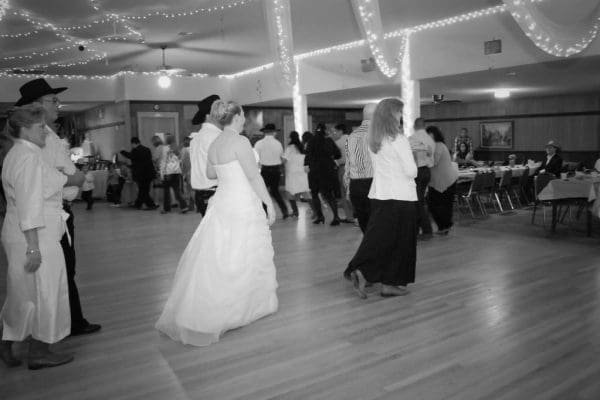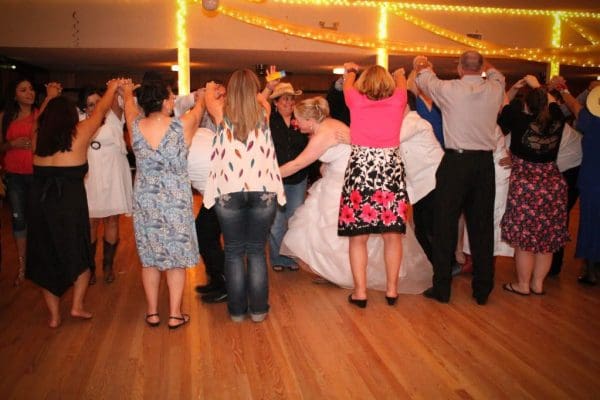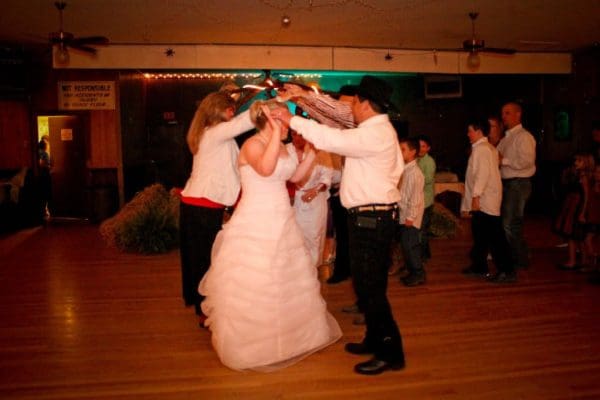What Is A Grand March At A Wedding? (+10 Grand March Songs)

Weddings are filled with traditions that add charm, sentimentality, and cultural richness to the celebration. One such tradition that continues to captivate wedding guests is the Grand March. This lively and festive procession holds a special place in many weddings, providing a beautiful start to the reception. We’ll dive into the history, significance, and modern interpretation of the Grand March, inviting you to embrace this joyous tradition and infuse your wedding with even more celebration and joy.
What Is The Grand March At Weddings?
The Grand March, also known as the Grand Entrance or Promenade, is a time-honored wedding tradition that originated in Europe. It traditionally takes place after the wedding ceremony or at the beginning of the reception, and it involves the newlywed couple leading their wedding guests in a lively procession. The Grand March is typically seen in Czech and German communities in Texas.
How Did The Grand March At Weddings Begin?
While the specific origins of the Grand March are not well-documented, it can be traced back to Europe in the 18th and 19th centuries. During this time, it was customary for couples to lead a procession or march, often accompanied by live music, into the wedding reception venue. This procession symbolized the newlyweds’ entrance into their new life together and was an opportunity for the couple to be formally introduced to their wedding guests.
Read More: How Many People Should I Invite To My Wedding? [Questionnaire]
The Wedding Grand March Tradition In The United States
The tradition of the Wedding Grand March was brought to the United States by European immigrants, particularly those from countries like Germany, Czech Republic and Poland. It was embraced and adapted by different communities, becoming a prominent feature of wedding celebrations, especially South Texan weddings.
In the United States, the Grand March evolved to include specific dance steps and formations. The dance progresses in a line or a circle, with couples moving in coordinated steps and patterns. Often, the music chosen for the Grand March is a lively polka or a wedding march.
When Should The Wedding Grand March Be?
The traditional Grand March is traditionally held during the wedding reception, often as a way to formally introduce the wedding party and the newly married couple to the wedding guests. It typically takes place after the ceremony and at the beginning of the reception. The exact timing can vary depending on the specific schedule and traditions of the wedding, but it’s commonly one of the first events at the reception, following the arrival of the guests and the wedding party at the reception venue.
In some traditions, the Grand March can also serve as a lead-in to the first wedding dance or to the opening of the dance floor for all guests. It’s a moment of celebration and can set the tone for the rest of the evening’s festivities. The key is to schedule it at a time when all the guests are present and attentive, usually before the meal is served or just as the formal dinner portion of the reception is concluding.
Steps of the Grand March In A Wedding
The wedding Grand March typically follows a set pattern of steps. However, variations can occur based on regional customs or personal preferences. The dance typically begins with a couple with many years of experience leading the procession on the dance floor, followed by the newlyweds. This is followed their parents and grandparents, the bridal party and the groomsmen, and then the rest of the guests. The basic steps include:
Step 1: Circular Motion
The couple begins the Wedding Grand March by being led in a circular motion around the room. This symbolizes the journey of life they are embarking on together.
Step 2: Momentary Separation
As the dance continues, the couple momentarily separates, representing the conflicts and challenges that may arise in their relationship.
Step 3: Reunion and Reconciliation
The couple reunites in a gesture of reconciliation, symbolizing their ability to overcome disagreements and find harmony.
Step 4: Joining in Rows
As the dance progresses, couples join together in rows, symbolizing the growth of their family and the bonds formed with their loved ones.
Step 5: Single-File Formation
The dance transitions back to a single-file formation, resembling a winding snake, representing the twists and turns that life may bring.
Step 6: Forming a Bridge
In a powerful moment, the couples come together, forming a bridge for each person to pass under. This act signifies the strength and support of the newlyweds’ bond, as their family and friends affirm their commitment.
Step 7: Dance Together
Finally, the newlyweds dance together while the wedding party and guests encircle them. This represents the encompassing support and love of their family and community throughout their married life.
Each step of the Grand March holds its own significance, contributing to the overall symbolism and meaning behind the dance. Together, these steps create a beautiful representation of the journey, challenges and support experienced in a couple’s married life.
5 Songs To Play During The Wedding Grand March
Traditional songs played during the Grand March at a wedding are often upbeat songs that evoke a sense of celebration. These songs have stood the test of time and are commonly associated with the traditional wedding grand march. Here are five classic and traditional song titles that you can give your wedding DJ to play during the Grand March.
- Under the Double Eagle (Unter dem Doppeladler) – J. F. Wagner
- Wedding March – Janicek Polka Band
- The Painted Gate Polka – The Czechaholics
- Farewell March (Na Rozloucenou) – Traditional Czech Song
- Grand March – Chris Rybak (Full CD)
Going with top songs on the adult contemporary charts is also a popular choice. Here are five newer songs that could be great choices for this moment, keeping in mind their upbeat nature and celebratory tones:
1. “Can’t Stop the Feeling!” by Justin Timberlake:
This upbeat and catchy song is perfect for creating an energetic and joyful atmosphere as the wedding party makes their entrance.
2. “24K Magic” by Bruno Mars
Known for its funky and lively beat, this song can add a fun and stylish vibe to the Grand March.
3. “Marry You” by Bruno Mars
With its romantic lyrics and cheerful melody, this song is a popular choice for weddings and can bring a sweet and happy energy to the procession.
4. Sugar” by Maroon 5
This upbeat and catchy tune, with its sweet lyrics, is fitting for a wedding setting and can set a joyous mood for the Grand March.
5. “Shut Up and Dance” by Walk The Moon
This song’s infectious energy and dance-worthy rhythm make it a great option for a lively and memorable Grand March.
Read More: How Many Slow Songs Should Be Played At A Wedding?
Modern Interpretations Of The Grand March:
While the traditional steps of the Grand March provide a framework, couples can personalize their wedding to reflect their unique style and preferences. They can choose music that resonates with them, incorporate cultural elements, or add creative touches that enhance the festive atmosphere. In modern weddings, the Grand March has evolved to adapt to different cultural practices and personal preferences. Some couples opt for variations, such as incorporating choreographed dances or surprise elements, while still preserving the essence of the tradition.
The Grand March also provides an excellent opportunity for photographers and videographers to capture dynamic and joyful moments. The candid shots of the couple dancing with their guests and the lively energy of the procession create treasured memories that will be cherished for years to come.
Final Thoughts On The Wedding Grand March:
The Grand March is a delightful and festive tradition that adds an extra layer of celebration to weddings. By leading their guests in a joyful procession, couples embrace the symbolic significance of starting their new life together surrounded by loved ones. Whether following the traditional steps or adding personal touches, the Grand March creates unforgettable memories and sets the tone for an exuberant and joy-filled wedding reception. Embrace this time-honored tradition and let the Grand March ignite your wedding celebrations with love, unity, and celebration.




![How Much Does A Live Wedding Painting Cost [+More Questions]](https://weddinghacked.com/wp-content/uploads/2023/12/how-much-does-a-live-painter-cost-wedding-guest-portrait.png)
![When to Book a DJ for Your Wedding [+DJ Interview Questionnaire]](https://weddinghacked.com/wp-content/uploads/2023/05/When-to-Book-a-DJ-for-Your-Wedding.png)

![100+ Not So Newlywed Game Questions For A Fun Game Night [Free Download]](https://weddinghacked.com/wp-content/uploads/2024/07/not-so-newly-wed-game-questions-game-night-pdf-free-printable-download.png)
![Do You Need A DJ For A Small Wedding? [+7 Fun Alternatives]](https://weddinghacked.com/wp-content/uploads/2023/05/do-you-need-a-dj-for-a-small-wedding-scaled.webp)
